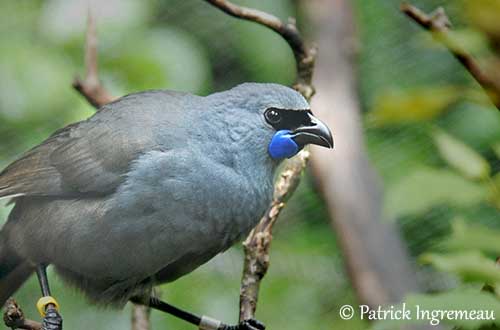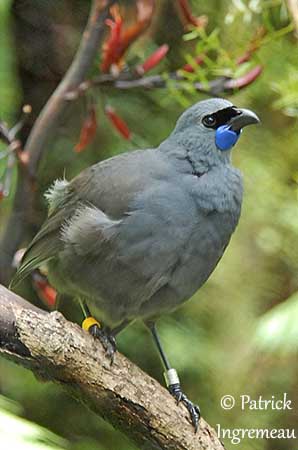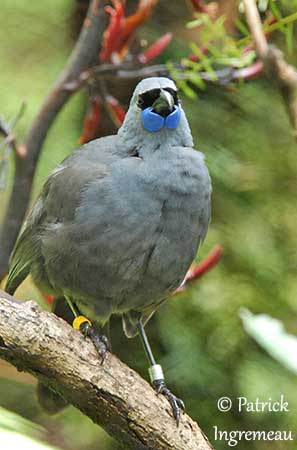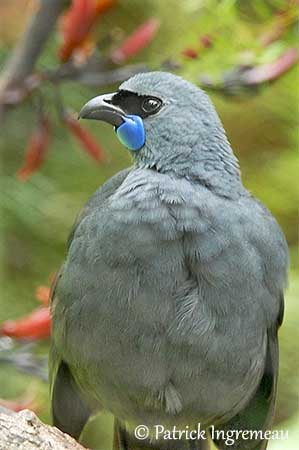
Fr: Glaucope de Wilson
Ang: North Island Kokako
Maori: Kokako
All: Graulappenvogel
Esp: Kokako
Nd: Noordelijke Kokako
Photographer:
Patrick Ingremeau
TAMANDUA
Text by Nicole Bouglouan
Sources:
HANDBOOK OF THE BIRDS OF THE WORLD Vol 14 by Josep del Hoyo-Andrew Elliot-David Christie - Lynx Edicions – ISBN: 9788496553507
KNOW YOUR NEW ZEALAND BIRDS by Lynnette Moon - New Holland Publishers – ISBN: 1869660897
BirdLife International (BirdLife International)
New Zealand bird status between 2008 and 2012
Wikipedia, the free encyclopaedia
Te Ara – The Encyclopedia of New Zealand
Tiritiri Matangi Open Sanctuary
Page family Callaeidae
Page Passeriformes Order
North Island Kokako
Callaeas wilsoni
Passeriformes Order – Callaeidae Family
INTRODUCTION:
The family Callaeidae is confined to New Zealand. There were two species of Kokako, but the South Island Kokako is probably extinct since 2007, in spite of several sight reports. Information is lacking.
Both were very similar in appearance, and only the bare parts were different, blue in C. wilsoni (here displayed) and orange in C. cinerea.
The North Island Kokako is present in tall native forest and is more often heard than seen. Thanks to active conservation measures, this species is slightly recovering since 2013.
DESCRIPTION OF THE BIRD:
Biometrics:
Length: 38 cm
Weight: 218-233 g
The adult has blue-grey plumage. The broad, rounded wings are blue-grey with olive-brown outer flight feathers, usually washed blue-grey. The long tail has rounded tip, and shows a distinctive downwards curve. The rectrices are blackish-brown with dark greyish-olive outer webs.
On the head, we can see a conspicuous black mask extending from the upperbase of the bill, around the eye to the gape. The wattles are cobalt-blue and arise from the lower base of the bill and the gape, extending down to the throat. During the breeding season, they increase in size and colour.
The strong, down-curved bill is black. The eyes are dark brown with greyish-black eyering. Legs and feet are black.

Both sexes are similar.
The juvenile resembles adult but it has mostly sooty blue-grey plumage and small, pink wattles.
The immature is mainly brownish-grey with mantle washed blue-grey. The wattles become bluish on edges, then purplish-pink and finally pinkish-blue. They increase in size while the bird is growing.
RANGE:
The North Island Kokako occurs on North Island in New Zealand, mainly in the northern half in scattered forests.
Since 1981, numerous birds have been successfully translocated to Little Barrier, Kapiti and Tiritiri Matangi Islands, and also Wairarapa, Hawkes Bay and East Cape areas.
HABITAT:
The North Island Kokako is a secretive forest bird which can be found in tall, diverse native forests with endemic tree species such as tawa or taraire, and emergent podocarps or kauri.
On Tiritiri Matangi Island, they breed in shrub and tree hardwoods. This species can be seen from sea-level up to 900 metres of elevation.
CALLS AND SONGS: SOUNDS BY XENO-CANTO
The North Island Kokako’s song can be heard throughout the year at dawn and dusk, but mainly during the breeding season in late spring and summer. It starts at sunrise and can last 60-90 minutes.
The song is a series of about 30 seconds, including long, melodic, haunting and mournful notes, like the sound produced by an organ. This series is followed by flute-like calls, clucks and mews.
The pair usually performs duets from high perches. The birds are silent during the day, except some quiet contact calls.

BEHAVIOUR IN THE WILD:
The North Island Kokako is a vegetarian species and feeds primarily on fruit and leaves, but it also takes moss, flowers, buds, nectar and invertebrates.
It forages during the day, alone or in pairs. However, after the breeding season, they can be seen in family groups.
It forages by gliding between trees and climbs slowly up the branches while feeding, before to glide to another tree. It may hold the food (mainly the leaves) with the feet like the Psittacidae species, while perching on stable perch. It picks fruits and gleans insects from the forest floor.
During the breeding season, the male performs displays such as “Archangel Displays”. It is perched in tree or on the ground, and raises the wings while moving them rapidly in front of its mate. It may carry some vegetation in the bill, but it repeatedly drops it.
Displays, pair-formation and maintenance of pair-bonds are accompanied by songs. All sexual and social behaviour include vocalizations. The courtship feeding by male to female is used to strengthen the pair-bonds.

The North Island Kokako is sedentary with some dispersion by juveniles, but only 1-2 kilometres.
This species is a weak flier, but it can fly at least at 50 metres above the ground. It prefers to progress through the trees by climbing from branch to branch, maintaining the balance with its rounded wings, before to glide down and move to next tree.
REPRODUCTION OF THIS SPECIES:
The breeding season occurs from October/November to March. This species can produce up to 3-4 broods per season in occasional years with abundant food resources, but usually, it raises one clutch.
They build a large cup-shaped nest with a base of sticks overlaid with ferns, lichen and moss. The inner cup is lined with leaves and finer twigs. The nest is well hidden among branches, or at top of tree-fern, among mass of lianas, but usually in the understorey or the subcanopy.
The female lays 2-3 eggs, and incubates during about 18 days. She broods the chicks which are fed by both parents. The young fledge between 32 and 37 days after hatching. They often remain in the territory for some months, and still depend on parents for food.

PROTECTION / THREATS / STATUS:
The North Island Kokako is threatened by rats and possums at nest. The populations of mammal pests are continually managed either on the mainland or on islands.
Former declines were due to habitat destruction involving forest fragmentation combined with introduction of predators.
Intensive conservation measures will allow restoring the population which is currently estimated at about 750 pairs, to more than 1000 pairs by the year 2020. The conservation status of the North Island Kokako has been moved from nationally vulnerable to “at risk – recovering” in 2013.
It is still listed as Endangered by BirdLife International.
